With the holidays in full swing, there’s a lot of talk about family. But what does family truly mean?
As our community shares below, it’s not just blood ties, and it’s not just the relatives you see twice a year. Family can really be found wherever you look: in senior housing, at a food pantry, down the street, and at your table. And unsurprisingly, food and family intersect more often than not.
Building Relationships after Retirement
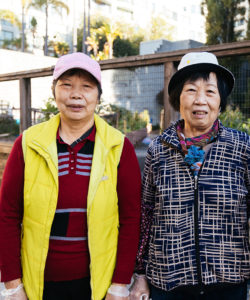
Cui Juzhu and Hui Yu are both retirees with a penchant for feeding others. Not only are they volunteers at the same SoMa food pantry where they pick up their groceries, but both women find a way to spread the love to neighbors who live in their senior housing building. “Some of my friends have disabilities, so they can’t come and walk to the pantry. So, I pick up my groceries, cook for my family, and then the rest I share with [my friends],” explained Hui Yu, who is a retired restaurant kitchen worker.
Cooking for others is an act of love; it’s saying, “you are family to me.” And it’s this kind of care that stretches to nourish whole families, friend groups, neighbor networks, and communities.
Found at a Pantry: “Second Family”
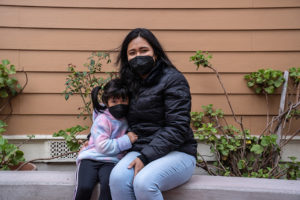 In sociology, there’s something called a “third place,” that describes a social environment outside of work or home where folks can congregate, see familiar faces, and build community. For María, the Friday food pantry in the Mission where she’s volunteered and picked up groceries for the past 10 years is a little of all the above.
In sociology, there’s something called a “third place,” that describes a social environment outside of work or home where folks can congregate, see familiar faces, and build community. For María, the Friday food pantry in the Mission where she’s volunteered and picked up groceries for the past 10 years is a little of all the above.
“I learn their names and their families. Some of them bring me food or coffee when it’s cold, and that’s really heart-touching. It feels good to know that someone else is watching over you. That someone cares about you, even when they are not even close-related, or cousins. They are like my second family.”
We often say that good food transforms lives. María shows us it’s no exaggeration — good food is a pathway to building community and building family.
Friends, Neighbors, Pantry Partners 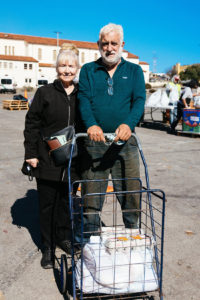
Janet and Bob are obviously close friends and neighbors: they finish each other’s sentences, tease each other, and laugh together. And as many folks can attest, friends are really chosen family. Both born and raised San Franciscans and retirees, Bob began giving Janet rides to their neighborhood food pantry in Stonestown where they pick up groceries together.
When we spoke in late October, Bob told us how he “fixes things for the neighborhood. I do all types of repairs – I worked in Silicon Valley for 30 years, so I know all about it.” Fences, wall dividers, you name it: folks in the neighborhood know to come to Bob for a repair. Janet, a retired caregiver, chimed in playfully: “I call Bob the house doctor.”
When folks don’t have to guess where their next meal will come from, it’s a lot easier to devote energy to investing in your community and friendships – something that Bob and Janet clearly do in equal measure.
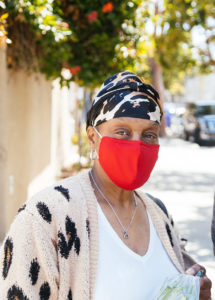 Sharing Space, Creating Memories
Sharing Space, Creating Memories
For Sharon, who we met at her neighborhood pantry in the Fillmore, it’s no sweat if the people gathering for her holiday feast are biological kin or not – it’s the act of coming together in a shared space to prepare a meal that creates family.
“Family is everything, you know? I’ve raised a pretty considerable amount of kids. I have four biological kids; I also have two foster children. And depending on my circumstances, I may accumulate a few more children at the table, it doesn’t matter. I’ve been a parent for a long time. After two kids, it doesn’t matter how many people sit at my table. It’s a joy, it’s a blessing. It’s a chance for us to connect when we all sit down together and eat, and I love that. The holidays are always great. It just feels good, when you and your family can sit down to a healthy meal and something that you enjoy. These memories are going to last a lifetime. It makes it all worthwhile.”
Happy Holidays and New Year
With that, we at the Food Bank would like to wish you happy holidays and a joyful start to 2023! We hope you’re able to take some time this month to sit down to a delicious, home-cooked meal that’s prepared with love. And we hope you can celebrate with family – whoever that may be.
See you in the New Year!



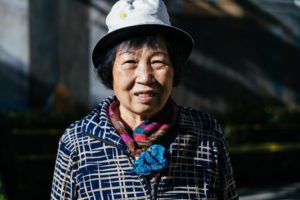 We met Hui Yu at her neighborhood pantry in the SOMA district, where she volunteers regularly and picks up groceries for her and her husband as well. Prior to retirement, Hui Yu worked in a restaurant kitchen, so she’s no stranger to feeding others. Now, she often cooks meals for friends in her senior living facility who can’t make it out to the pantry. Poultry was at the top of Hui Yu’s list as a holiday main: “
We met Hui Yu at her neighborhood pantry in the SOMA district, where she volunteers regularly and picks up groceries for her and her husband as well. Prior to retirement, Hui Yu worked in a restaurant kitchen, so she’s no stranger to feeding others. Now, she often cooks meals for friends in her senior living facility who can’t make it out to the pantry. Poultry was at the top of Hui Yu’s list as a holiday main: “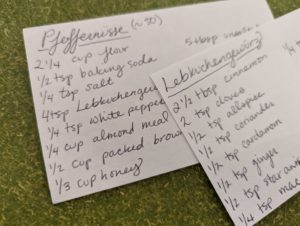 cookies)
cookies)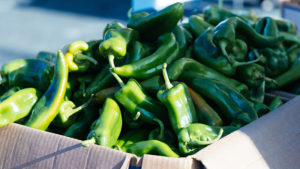 basis, traditional recipes that comes down from your family. My favorite recipe that was passed down to me is my mother’s okra.” At first thoughtfully pondering what else makes up her usual holiday table, Barbara began quickly listing other favorites: “
basis, traditional recipes that comes down from your family. My favorite recipe that was passed down to me is my mother’s okra.” At first thoughtfully pondering what else makes up her usual holiday table, Barbara began quickly listing other favorites: “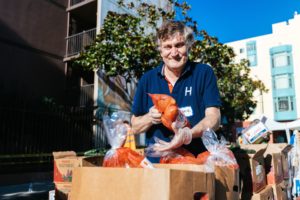 neighborhood pantry. He’s a military retiree and a volunteer at his local pantry, where he also picks up groceries for him and his wife. For his family, the holidays are about the joining of different traditions. “I have a traditional turkey dinner, where I usually go up to my sister’s house for Thanksgiving. And then I host a turkey dinner for my wife’s family. My wife’s Chinese, so we tend to do Chinese vegetables, mashed potatoes and cranberries [on the side].”
neighborhood pantry. He’s a military retiree and a volunteer at his local pantry, where he also picks up groceries for him and his wife. For his family, the holidays are about the joining of different traditions. “I have a traditional turkey dinner, where I usually go up to my sister’s house for Thanksgiving. And then I host a turkey dinner for my wife’s family. My wife’s Chinese, so we tend to do Chinese vegetables, mashed potatoes and cranberries [on the side].”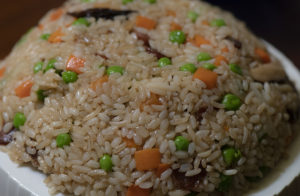 As Program Manager at the Food Bank, Kim is around good food quite a bit! But nothing quite compares to her family recipe for naw mai fan. “This is my mom’s recipe. She learned how to make this from my grandmother, an immigrant from the
As Program Manager at the Food Bank, Kim is around good food quite a bit! But nothing quite compares to her family recipe for naw mai fan. “This is my mom’s recipe. She learned how to make this from my grandmother, an immigrant from the 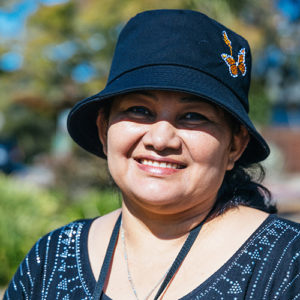 Sharing is caring! María is a mom, volunteer, and pantry participant in San Rafael. She told us that her family embraces potlucks during the holidays, but also for camping trips and other gatherings throughout the year.
Sharing is caring! María is a mom, volunteer, and pantry participant in San Rafael. She told us that her family embraces potlucks during the holidays, but also for camping trips and other gatherings throughout the year. 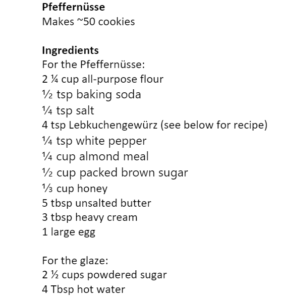
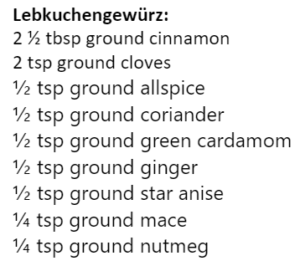
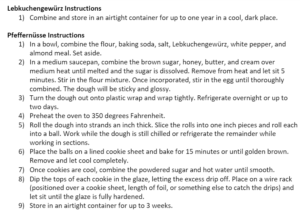
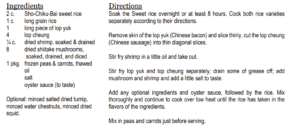
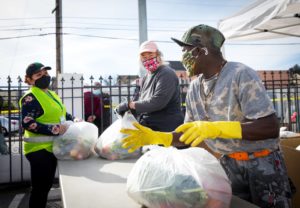
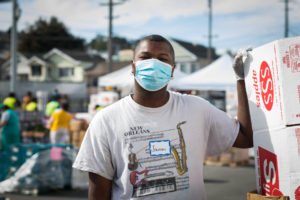
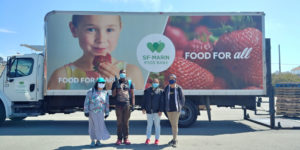
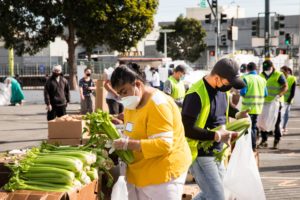
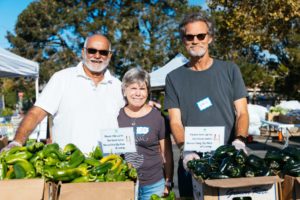 COVID Pantry Pivots
COVID Pantry Pivots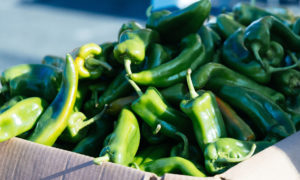
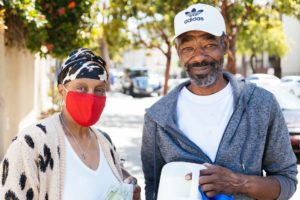
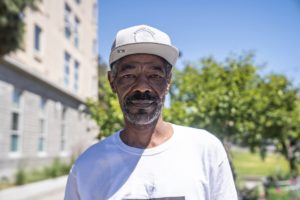 Cliffton: My biggest thing is for my people to get educated. What you know, they can’t take that away from you. If you want to stay in your community, you’ve got to find a way. Educate yourself on what City Hall is doing for your community, what you can do for your community. I’m helping set up the
Cliffton: My biggest thing is for my people to get educated. What you know, they can’t take that away from you. If you want to stay in your community, you’ve got to find a way. Educate yourself on what City Hall is doing for your community, what you can do for your community. I’m helping set up the 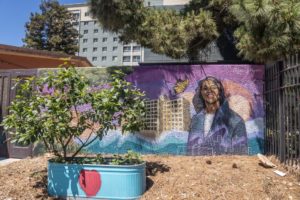 you’ve got good people around you, when you’re cooking, and you got people over and everything… take the food away, you got chaos. If you got a group of people together, bring
you’ve got good people around you, when you’re cooking, and you got people over and everything… take the food away, you got chaos. If you got a group of people together, bring
Share